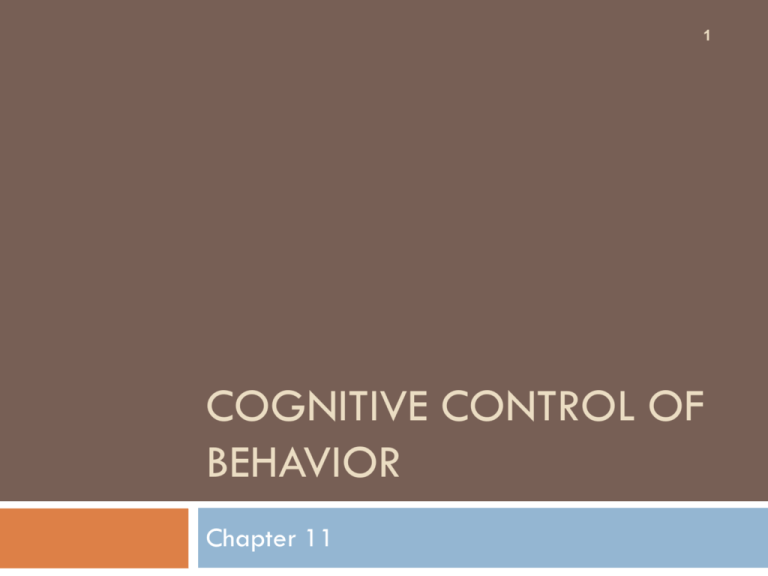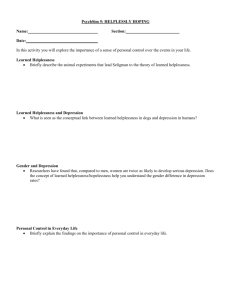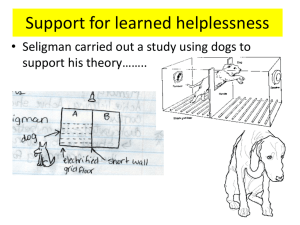Cognitive Control of Behavior
advertisement

1 COGNITIVE CONTROL OF BEHAVIOR Chapter 11 Animal Cognition 2 Aristotle •Scala Naturae •God •Angels and Demons •Man •Wild Beasts •Domesticated Beasts •Plants •Minerals Born 384 BC Charles Darwin 4 Evolution by Natural Selection Mental continuity between humans and animals. Descent of Man “Nevertheless the difference in mind between man and the higher animals, great as it is, certainly is one of degree and not of kind.” 1809-1882 Georges Romanes 5 Animal Intelligence (1888) Relied heavily on anecdotes to build an uncritical view of animal intelligence Criteria for Mind: 1. Not a reflex 2. Individual Choice 3. Report by a Reputable Person 1848-1894 Some Examples 6 Horses and inclined planes Earwig “Tim” comes to breakfast Cats and mechanical understanding Scorpions commit suicide Sympathetic ants Excerpted from George Romanes' book Animal Intelligence (1888) 7 One day, watching a small column of these ants, I placed a little stone on one of them to secure it. The next that approached, as soon as it discovered its situation, ran backwards in an agitated manner, and soon communicated the intelligence to the others. They rushed to the rescue; some bit at the stone and tried to move it, others seized the prisoner by the legs and tugged with such force that I thought the legs would be pulled off, but they persevered until they got the captive free. This observation seems unequivocal as proving fellow-feeling and sympathy. Ontogeny Recapitulates Phylogeny 8 Romanes Evolution of Intelligence 9 15 Months 12 Months 8 Months 4 Months 7 Weeks 3 Weeks Morality Tool Use Understand Words Recognize People Similarity Contiguity Caveat Emptor 10 Anthropomorphism: unthinkingly giving human qualities to animals, especially when the data are anecdotal Teaching Signs to Washoe 11 Edward Thorndike 12 Criticized Romanes’ views as unscientific. Problems with anecdotes: 1. Only a single case is studied. Does it apply to whole species? 2. Observations are often not repeated or repeatable 3. Conditions under which observations are made are not well regulated 4. Do not know history of the animal 1874-1949 Lloyd Morgan and Tony 13 “Tony” 1852-1936 Morgan’s Canon 14 “In no case may we interpret an action as the outcome of the exercise of a higher psychical faculty, if it can be interpreted as the outcome of one which stands lower in the psychological scale.” Caveat Emptor 15 Anthropomorphism: unthinkingly giving human qualities to animals Equality of Condition: assumption that it is possible to truly equate test conditions, and thus place species on a scale Speed of learning and intelligence 16 Are infants dumber than bees? Are bees smarter than rats? Caveat Emptor 17 Anthropomorphism: unthinkingly giving human qualities to animals Equality of Condition: assumption that it is possible to truly equate test conditions Evolutionary Scale: assumption that living species are close genetic relatives, with organisms of lesser complexity having evolved into more complex ones. Evolution of Intelligence 18 Brain Size 19 Dumb and dumber 20 Tree of life 21 Caveat Emptor 23 Anthropomorphism: unthinkingly giving human qualities to animals Equality of Condition: assumption that it is possible to truly equate test conditions Evolutionary Scale: assumption that living species are close genetic relatives with organisms of lesser complexity having evolved into more complex ones. Homology or analogy: Common genes or common environmental pressures? Learned Helplessness Theory 24 Seligman – depression is learned. Depression occurs when people believe: Failures are due to uncontrollable events. Failure will continue as long as events are beyond their control. Depression arises from helplessness. Animal Research 25 Step 1 -- three groups of dogs: Inescapable shock – no control. Escapable shock -- terminated if the dog pressed a panel. No shock Step 2 – 10 trials of signaled avoidance training in shuttle box. 2/3 of inescapable shock dogs did not learn to jump during step 2. Characteristics of Helplessness 26 Motivational – unable to initiate voluntary behavior. Mice in water maze. Nonspecific – carries over to a variety tasks and test situations. Learning– incapable of benefiting from future experience – even if they jump, don’t learn. Emotional– negative affect, ahedonia (sad) Helplessness in Humans 27 Hiroto – three groups of college students: Uncontrollable group – wrongly told that pushing button would end noise. Escapable group – pushing button ended noise. Control – no noise. Tested using finger shuttle box. Uncontrollable group did not escape Cognition and helplessness 28 It is important to appreciate that although cognition is at the heart of Seligman's theory, learned helplessness affects other psychological processes A Cognitive View Of Depression 29 Seligman believed that depression is learned He proposed that depression occurs when people believe that they are helpless to control their own destinies Studies of Depressives 30 Show similar results to learned helplessness studies. Depressed individuals do not escape noise, responding like inescapable non-depressed individuals. Depressed individuals do not adjust likelihood of succeeding upward when they experience success. They credit chance not skill. Parallels (Symptoms) 31 Helplessness Response initiation deficit Reinforcement ineffective in changing behavior Attentional shift (Turn Outward) Emotionally passive Recall aversive Reduced Aggression Lose Weight Norepinephrine depletion Glutamate overactivity Depression Unresponsive, slow Disrupted thinking, negative expectations Attentional shift (Turn Inward) Flat Ruminations Occasional Angry Outbursts Anorexia Norepinephrine depletion Glutamate overactivity Parallels (Treatments) 32 Antidepressants ECT Forced escape Time Antidepressant ECT Behavioral Efficacy Treat Time Criticisms of Seligman’s Theory 33 May be due to attributions, not everyone who experiences uncontrollable events becomes helpless. Failure to replicate performance deficits in humans – facilitation of performance instead (Get Mad). 34 Depressed individuals attribute their success to external factors of luck and task ease Depressed individuals attribute their failures to internal factors of lack of effort and ability 35 Non-depressed individuals attribute successes to internal factors and failures to external factors Learned helplessness models cannot explain such observations Attribution Theory 36 Causal attributions of failure have three dimensions: Internal-external – internal traits or characteristics vs environmental forces Stable-unstable – past causes will persist vs new forces will determine future outcomes Global-specific – outcome relates only to one task vs outcome effects everything. Attributional Model of Depression 37 Internal Dimension Stable External Unstable Stable Unstable Global I’m unattractive to all men My conversation sometimes bores men Men are overly competitive with intelligent women Men get into rejecting moods Specific I’m not his “type” My conversation bored him He’s overly competitive with women He was in a rejecting mood Severity of Depression 38 Depression can be transient if attributed to global but changing conditions. Severe depression occurs when attributions are: Internal Global Stable Unlikely if external, specific, unstable. Two Kinds of Helplessness 39 Personal helplessness – an individual’s inability causes failure. Universal helplessness – the environment is structured so that no one can control future events. Abramson -- both kinds lead to depression. Vary on external-internal dimension. Low self-esteem only with personal. 40 Both personal and universal helplessness produce the expectation of an inability to control future events and a lack of an ability to initiate voluntary behavior, which are characteristic of depression Individuals who are personally depressed make internal attributions for failure (MANY PEOPLE) Individuals who are universally depressed make external attributions for failure (LIKE DOGS & RATS) Severity of Depression 41 Severe depression typically appears when a person attributes their failure to internal, global, and stable factors The depression is intense because they perceive themselves as incompetent (internal) in many situations (global) and believe the incompetence is unlikely to change (stable) Hopelessness Theory of Depression 42 The hopelessness theory suggests that attributional style AND/OR environmental circumstances together contribute to hopelessness Hopelessness Depression 43 Hopelessness – the expectation that desired outcomes will not occur. Learned helplessness -- no control over undesired outcomes. Accounts for anxiety without depression. Anxiety – possibility that a person may have no control over negative events. Depression occurs when certain. Negative Life Events and Hopelessness 44 Hopelessness: The belief that negative events are inevitable Occurs when a negative life event is attributed to stable and global factors Hopelessness Theory of Depression: The view that whether a person becomes hopeless and depressed depends upon a person making a stable and global attribution for negative life events and the severity of those negative life events A Negative Attributional Style and Vulnerability to Depression 45 Negative attributional style: A belief system that assumes that negative life events are due to stable and global factors, which makes the person vulnerable to depression A Positive Attributional Style and Hopelessness Depression 46 Positive attributional style: A belief system that negative life events are controllable, which leads to hopefulness and a resilience to depression Hopefulness: The belief that negative life events can be controlled and are not inevitable






